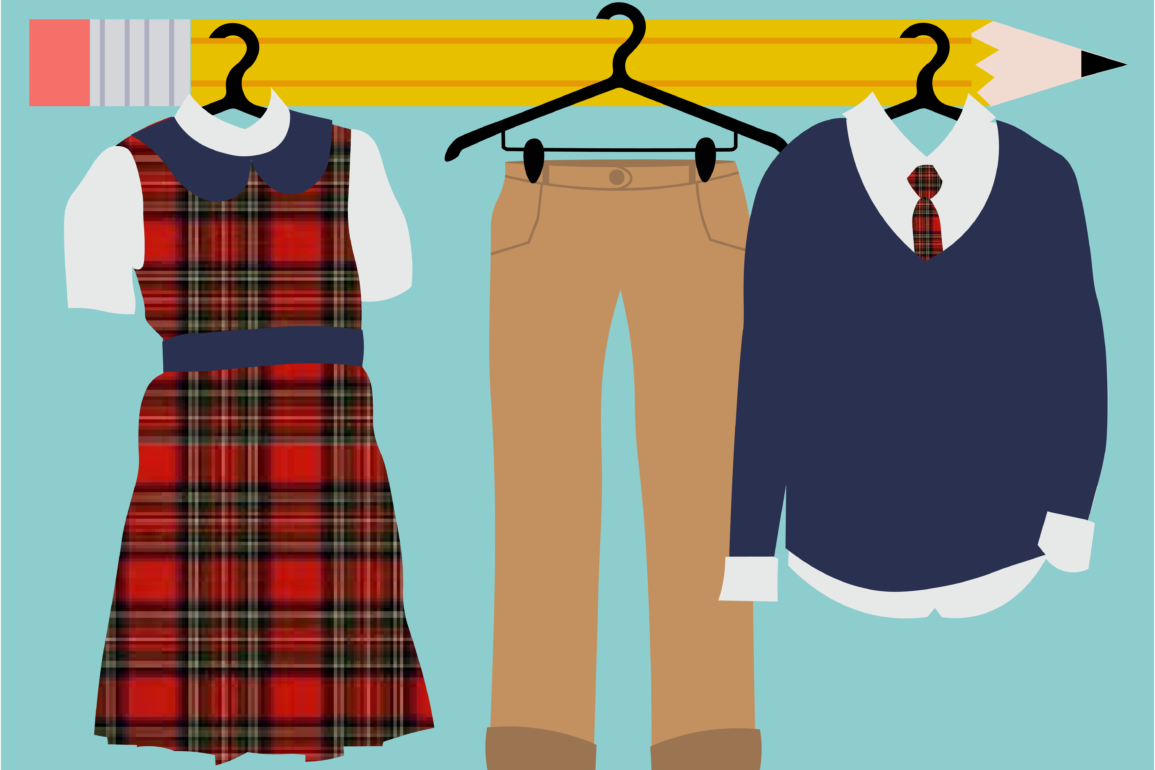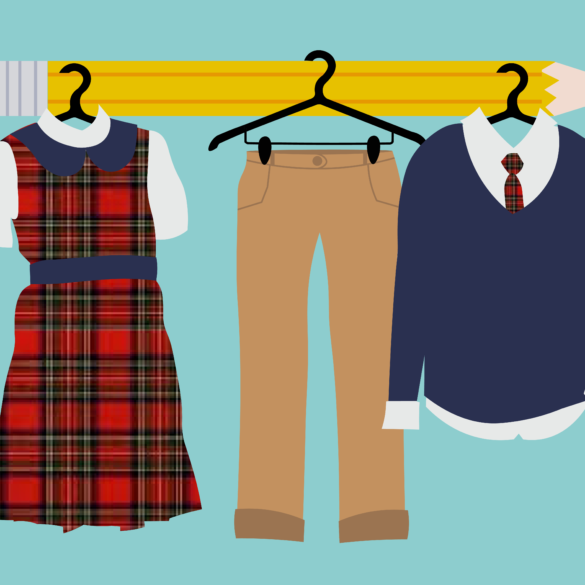The views expressed in an op-ed don’t necessarily reflect the views of Ball Bearings Magazine.
A history of school uniforms and how they impact the students that wear them.
As a freshman in college, I got to pick exactly what I wanted to wear to school for the first time in my life. Before college, my outfit was planned out for me every day. From kindergarten through eighth grade, it was a navy skirt or jumper with beige and maroon plaid stripes. For high school, it was a dreadful khaki skirt that resembled a burlap sack. The only thought put into what I wore to school for those eight years was which solid-colored button-up shirt with my school’s crest I would choose that day.
My experience with uniforms is not unique. Approximately 20% of all public school students in the United States and 73% of all private school students in the United States wear uniforms to school, according to the National Center for Education Statistics. Although traditionally it is more common for private schools, like the Catholic elementary and high schools I attended, to require uniforms, more and more public schools are starting to implement them.
Uniforms have been a topic of debate among schools for a long time. They can have profound and lasting impacts on students and have both positive and negative effects. Public and private schools should consider the pros and cons before implementing a uniform policy.
When uniforms were first introduced to American schools in the early 1900s, school officials hoped that it would spark a sense of community. According to a New York Times Report, schools in Maryland and Washington D.C. were among the first in the United States to implement uniforms. After these schools noticed positive changes in students’ attitudes and a decline in disciplinary issues, other schools across the nation began implementing uniforms in hopes of seeing similar results.
A 2016 study published in the International Journal of Educational Management found that the use of uniforms is directly correlated with increased attendance and academic focus. Uniforms seem to have positive effects on the students’ behaviors as well. A study by Trutex found that seven out of 10 students thought wearing school uniforms helped them to fit in and nine out of 10 teachers thought that uniforms helped stop bullying.
Schools with uniforms tend to have less violence, too. One study published in the International Journal of Education Policy and Leadership found that schools with uniform policies have 12% fewer firearm-related incidents and 15% fewer drug-related incidents than schools without uniforms. Logically, uniforms may deter students from attempting to carry weapons since they would not be able to conceal them under baggy clothing.
Not all school uniforms are created equal. In my K-8 school, our strict dress code and uniform policy was on the more extreme side of the spectrum. Our shoes had to be black and our socks had to be neutral colors. Having your shirt untucked one too many times was grounds for being sent to the principal’s office. Boys had to keep their hair short and girls weren’t allowed to have their nails painted, wear make-up or “distracting” jewelry, or dye their hair.
I remember one instance where my seventh grade biology teacher made a girl in my class come to the front of the classroom and use a makeup wipe to remove her mascara in front of everyone. There were multiple Monday mornings that I was sent to the nurse’s office, where they kept nail polish remover and cotton balls, to take off my nailpolish left over from the weekend.
Not all schools with uniforms require plaid skirts, button up shirts, cardigans, ties, and makeup-free faces. Particularly in public schools, it has become the standard to allow students to wear any T-shirts, polo shirts, and sweatshirts that match the school’s colors. Plain-colored pants and, in some cases, even jeans are allowed, as well.
The most common argument against uniforms is that they limit students’ freedom of expression. A Swedish government agency called the School Inspectorate determined that uniforms were a human rights violation because “dress and appearance should be considered an individual expression, decided by the students themselves.”
In my experience, requiring a uniform can force students to abandon individuality and uniqueness, rather than embrace it. Although uniforms may create a sense of community and belonging, it also tells students that they have to conform and sacrifice their originality to be a part of that community.

In general, most students don’t enjoy wearing uniforms. A 2017 survey found that 82% of current students opposed wearing uniforms. Reasons for this unanimous hatred of uniforms vary. Some students dislike how uncomfortable uniforms can be. Others simply wish they had more freedom of expression through their clothes. And others, including myself, agree that uniforms are not flattering for all body types and can foster insecurities.
I believe that little girls shouldn’t have to stand in front of a mirror and wonder why the exact clothes they wear look so much different, so much “better,” on someone else. They shouldn’t be forced to wear a skirt that shows the legs they wish they could hide behind loose pants or a shirt that hugs their torso a little too tight for comfort. Uniforms were created to make students feel like equals, but, in my experience, they acted as a measure by which I constantly compared myself to my classmates.
Each year, Americans spend around $1 billion on school uniforms. Putting kids through school is expensive enough already. Uniforms add to the very long list of back-to-school supplies that parents are expected to provide their children with each year.
The push for school uniforms seems to be driven by commercial interests, rather than educational ones. In one year alone, Lands’ End, one of the major uniform production companies in the nation, spent $3 million on marketing efforts directed at public schools and districts. Additionally, multiple studies used to promote the effectiveness of uniforms were at least partially funded by Lands’ End.
With this in mind, it’s important that these studies are looked at with a skeptical eye. Although the results of some studies show positive impacts of school uniforms, others have found that they can have little to no effect, and in some cases even negative effects, on students. There’s a lot of things schools should consider before deciding whether or not to require uniforms, because the effects will stick with students long after they hang up the skirts and ties.




